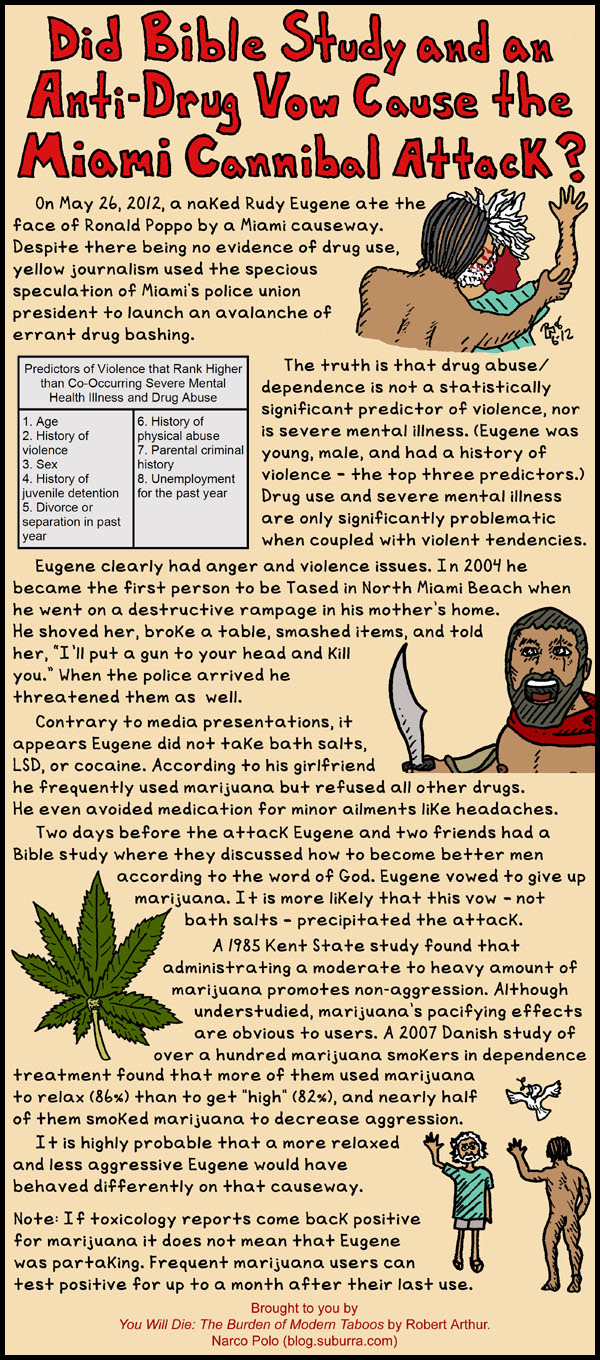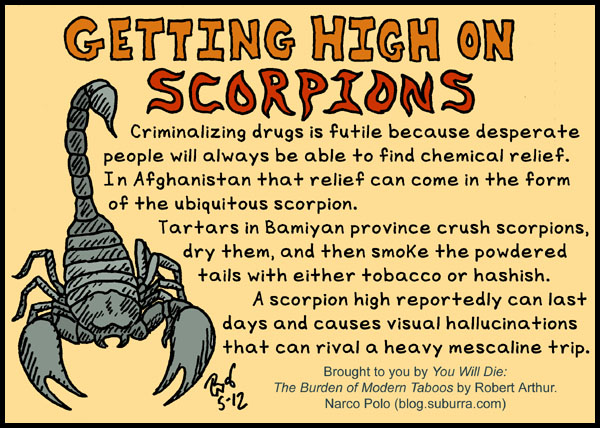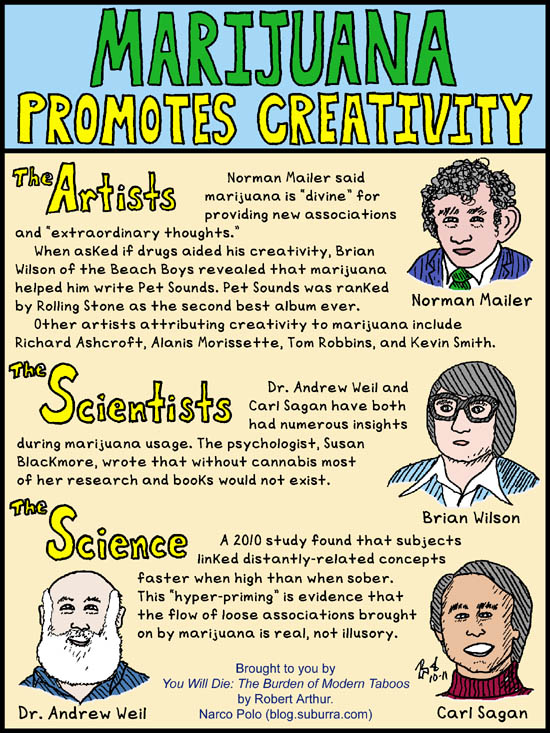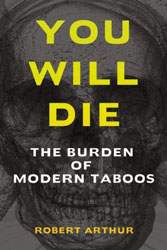Posted: June 4th, 2012 | Filed under: bath salts, cocaine, drugs, hallucinogens, LSD, marijuana, media bias | 5 Comments »

(For more information on bath salts read “Doctor Tried Bath Salts and Liked It: In Defense of Bath Salts,” or learn about the “Legal Drug Linked to More Cannibalism than Bath Salts.”)
On May 26, 2012, a naked Rudy Eugene ate the face of Ronald Poppo by a Miami causeway. Despite there being no evidence of drug use, yellow journalism used the specious speculation of Miami’s police union president to launch an avalanche of errant drug bashing.
The truth is that drug abuse/dependence is not a statistically significant predictor of violence, nor is severe mental illness. (Eugene was young, male, and had a history of violence – the top three predictors.) Drug use and severe mental illness are only significantly problematic when coupled with violent tendencies. (2,5)
Eugene clearly had anger and violence issues. In 2004 he became the first person to be Tased in North Miami Beach when he went on a destructive rampage in his mother’s home. He shoved her, broke a table, smashed items, and told her, “I’ll put a gun to your head and kill you.” When the police arrived he threatened them as well. (3)
Contrary to media presentations, it appears Eugene did not take bath salts, LSD, or cocaine. According to his girlfriend he frequently used marijuana but refused all other drugs. He even avoided medication for minor ailments like headaches.
Two days before the attack Eugene and two friends had a Bible study where they discussed how to become better men according to the word of God. Eugene vowed to give up marijuana. It is more likely that this vow – not bath salts – precipitated the attack.
A 1985 Kent State study found that administrating a moderate to heavy amount of marijuana promotes non-aggression. (4) Although understudied, marijuana’s pacifying effects are obvious to users. A 2007 Danish study of over a hundred marijuana smokers in dependence treatment found that more of them used marijuana to relax (86%) than to get “high” (82%), and nearly half of them smoked marijuana to decrease aggression. (1)
It is highly probable that a more relaxed and less aggressive Eugene would have behaved differently on that causeway.
Note: If toxicology reports come back positive for marijuana it does not mean that Eugene was partaking. Heavy marijuana users can test positive for marijuana for up to a month after their last use.
Tip of the Hat
I salute the following journalists for writing articles criticizing the fallacious and narcophobic coverage of the Causeway Cannibal:
1. Kristen Gwynne, “Dumb and Dangerous Anti-Drug Propaganda in the Miami Zombie Story,” AlterNet.org. 31 May 2012. LINK
2. Jacob Sullum, “If You Use Drugs, You Might End Up Eating Someone’s Face,” Reason.com, 29 May 2012. LINK
3. Maia Szalavitz, “Why Drugs Are Getting a Bum Rap in the Miami Face-Eating Attack,” Time.com, 30 May 2012. LINK
Addendum (June 28, 2012) – The full toxicology report of Rudy Eugene released on June 27, 2012 reported that the only drug found in his body was marijuana. The common chemicals in drugs sold as bath salts were absent. LINK
Sources
1. Mikkel Arendt, et al., “Testing the Self-Medication Hypothesis of Depression and Aggression ….,” Psychol. Med., 2007, 37.
2. Eric Elbogen & Sally Johnson, “Intricate Link Between Violence and Mental Disorder,” Arch. Gen. Psychiatry, Feb. 2009.
3. Gus Garcia-Roberts, “Rudy Eugene to Mother in 2004 ….,” MiamiNewTimes.com, 30 May 2012.
4. Rodney Myerscough & Stuart Taylor, “Effects of Marijuana on Human Physical Aggression,” J. Pers. Soc. Psychol., 1985, 49(6).
5. Rick Nauert, “Mental Illness Does Not Predict Violence,” PsychCentral.com, 26 Feb. 2009.
Posted: May 10th, 2012 | Filed under: drugs, hallucinogens, marijuana, opiates | 13 Comments »

David Macdonald argues in his 2007 book, Drugs in Afghanistan, that Afghanistan’s increased drug usage is driven by an impoverished battle-scarred population trying desperately to relieve its suffering.* Western-led efforts to universally criminalize drugs are futile because distressed people will always be able to find chemical relief.
As an example, Macdonald notes that in Afghanistan even the ubiquitous scorpions can be used for intoxication. Tartars in Bamiyan province prepare scorpions by smashing them between stones and letting them dry. The main part of the tail, with the sting, is then crushed into a powder and smoked with tobacco and/or hashish (marijuana).
A friend of Macdonald’s who witnessed a man smoke scorpion in the Afghan town of Peshawar described the reaction:
The effect was instantaneous with the man’s face and eyes becoming very red, “much more than a hashish smoker” …. He also seemed very intoxicated but awake and alert, although he stumbled and fell over when he tried to rise from a sitting position …. the smoke tasted “sweeter” than that of hashish, although … it smelled foul, and the intoxicating effect lasted much longer. (1, p. 247)
As with most drugs, anecdotal reports of scorpion’s effects vary widely. It is likely that the numerous Afghan scorpion species have divergent psychoactive properties. Scorpion has been reported to keep one awake, cause severe headaches, and rival the effects of a “strong mescaline trip.” (1, p. 248) One Kabul man who had smoked between 20 and 30 times reported the effects to last three days. During these periods he had difficulty opening his eyes, his head spun, and he had constant visual hallucinations.
Globally, scorpion smoking is still rare. The failure of the war on other drugs has not driven people to seek it out … yet. If drug war success sparking scorpion use sounds unbelievable, in India’s Western states police crackdowns on mainstream illicit drugs have already led to “sting sellers.” A police officer in the city of Bharuch said:
Because of our successful drives against the sellers and addicts of alcohol, opium, cough syrup, and heroin in urban areas, young people are flocking on the highways to try the new craze of scorpion stings. (2)
The futility of drug criminalization may become comically clear if more drug war “victories” bring about a war on arachnids.
* Macdonald is a sociologist who has specialized in drug control for over 20 years. From 1999 until his book’s publication in 2007 he served as the demand reduction adviser for the UN drugs control program in Afghanistan with UNODC and also with the Ministry of Counter Narcotics in Kabul.
Sources
1. David Macdonald, Drugs in Afghanistan: Opium, Outlaws, and Scorpion Tales (2007). LINK
2. “New Drugs Craze Has a Scorpion Sting in the Tail,” Scotsman.com, 25 Apr. 2004. LINK
Posted: October 21st, 2011 | Filed under: drugs, marijuana | 19 Comments »

The Artists
The writer, Norman Mailer, said that marijuana is “divine” for providing one with new associations and “extraordinary thoughts.” (6) His 1948 book, The Naked and The Dead, is regarded as one of the best novels of the 20th century.
When asked if drugs aided his creativity Brian Wilson of the Beach Boys replied, “Very much so, yeah. Marijuana helped me write Pet Sounds.” (4) Pet Sounds was ranked by Rolling Stone magazine as the second greatest album of all time. (2)
The author, Tom Robbins, has said:
The plant genies don’t manufacture imagination, nor do they market wonder and beauty – but they force us out of context so dramatically and so meditatively that we gawk in amazement at the ubiquitous everyday wonders that we are culturally disposed to overlook, and they teach us invaluable lessons about fluidity, relativity, flexibility, and paradox. Such an increase in awareness, if skillfully applied, can lift a disciplined, adventurous artist permanently out of reach of the faded jaws of mediocrity. (11)
This is echoed by the musician Richard Ashcroft of The Verve:
Anything that can take you to beyond where you naturally are when you wake up in the morning can have some creative effect, can have some way of spinning the way you look on life …. I smoke the weed every day, and to me, that is the thing I’ve found is best for making music. (3)
Other artists who have attributed creative assistance to marijuana include director Kevin Smith and the musician Alanis Morissette. (10, 8) Their words can be found here and here respectively.
The Scientists
Dr. Andrew Weil wrote that many of the ideas in his best-selling book, The Natural Mind (1972), came to him when he was high on marijuana. (12)
The astronomer and author, Carl Sagan, attributed numerous insights to marijuana and has defended this inspiration from those who call it illusory. (5) To read his entire treatise on the cerebral benefits of marijuana use go to this link.
The psychologist, Susan Blackmore, has written, “I can honestly say that without cannabis, most of my scientific research would never have been done and most of my books on psychology and evolution would not have been written.” (1)
The Science
One way in which creativity can be described is the ability to find new and novel connections between concepts. In scientific terms the ability to find connections between words is called semantic priming. A 2010 study published in Psychiatry Research found that the use of marijuana induces a state of hyper-priming. (9) When presented with an activation word, subjects reacted faster to distantly-related words when high than when sober. (For a neuroscience journalist’s take on this study go here.) The flow of loose associations promoted by marijuana is a real phenomenon.
Credit goes to Jason Silva for introducing me to this study. His article on marijuana’s “butterfly effect” on thought can be found here.
Addendum (June 25, 2012) – Steve Jobs, co-founder of Apple, told government investigators during a background check in 1988, “The best way I would describe the effect of the marijuana and the hashish is that it would make me relaxed and creative.” (13)
Sources
1. Susan Blackmore, “I Take Illegal Drugs for Inspiration,” Daily Telegraph, 21 May 2005. LINK
2. Pat Blashill, et al., “500 Greatest Albums of All Time,” RollingStone.com, 2003. LINK
3. “Captain Beaky and His Bands,” Q, Feb. 2001, p. 53.
4. Jian Ghomeshi, “Brian Wilson Talks About Drug Use on QTV,” Q with Jian Ghomeshi, 20 May 2011. LINK
5. Lester Grinspoon, Marihuana Reconsidered (1971).
6. Russ Kick, Disinformation Book of Lists (2004), p. 28.
7. Jonah Lehrer, “Marijuana and Divergent Thinking,” The Frontal Cortex, 10 Mar. 2010. LINK
8. John Luersson, “Alanis Morissette Credits Marijuana for Creativity,” Spinner.com, 1 Dec. 2009. LINK
9. C.J. Morgan, et al., “Hyper-Priming in Cannabis Users,” Psychiatry Research, 30 Apr. 2010. LINK
10. “Pot Smoking ‘Saved’ Kevin Smith,” NYPost.com, 5 Oct. 2009. LINK
11. Jacob Sullum, Saying Yes (2003), p. 157.
12. Andrew Weil, The Natural Mind (1998), p. 196.
13. Kim Zetter, “Steve Jobs’ Pentagon File: Blackmail Fears, Youthful Arrest and LSD Cubes,” Wired.com, 11 June 2012. LINK





